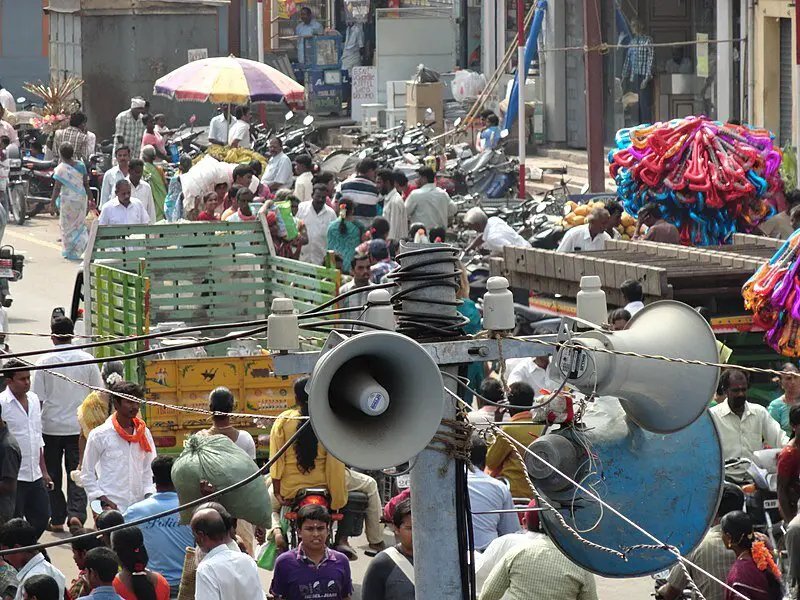Noise Pollution Definition, Measures and Importance Explained
Noise pollution is a type of environmental degradation whereby acoustic waves travel with hazardously-high and unregulated intensity within an area. This article discusses noise pollution definition, measures and importance, as outlined below;
-Noise Pollution Definition: 7 Ways to Define Noise Pollution
-Measures of Noise Pollution Control
-Importance of Noise Pollution
Noise Pollution Definition: 7 Ways to Define Noise Pollution
Noise pollution is any process involving the propagation of excessive and disturbing sound waves within a given area, such that it has harmful environmental impacts with respect to both abiotic and biotic aspects of the ecosystem.
The above is a basic definition of noise pollution, which highlights the concept holistically in terms of its causes and effects.
More clarity on the meaning of noise pollution can be achieved by considering its various attributes individually. One of these attributes is the causes of noise pollution.
Below is an alternative noise pollution definition that lists some of its causes;
Noise pollution is a form of environmental degradation that occurs when unwanted sounds exceed 65 decibels (dB) in a given area, as a result of any of various natural and manmade causes like; high-volume automobile traffic [1], industrial activities, unregulated use of electrical sound-amplifiers (like speakers), volcanic eruptions, and thunderstorms.

To have a well-rounded view of its importance as an environmental issue, it will help to highlight both the causes and effects of noise pollution. Some of these effects are listed in the alternative noise pollution definition that is given below;
Noise pollution is a condition of significant and prolonged acoustic disturbance as a result of loud, irregular and/or unwanted sounds, with effects such as; economic loss, biodiversity decline, and human health problems like; high blood-pressure, cardiovascular disease [2], and hearing loss.
As implied above, noise pollution, when present for long periods in natural ecosystems like forests, can reduce species richness, biodiversity and overall biological productivity, by altering the living patterns of organisms, which may develop counterproductive behaviors to cope with the disturbance, or may migrate to another area entirely.
It is important to note that there is a difference between the causes and sources of noise pollution. The former is focused on processes and activities that directly release noise into the environment, while the latter focuses entities or systems that serve as reservoirs or breeding-points for the causes of noise pollution.
In the alternative noise pollution definition below, some of its sources are listed;
Noise pollution is the disruption of environmental equilibrium due to loud, irregular and prolonged sound-propagation from any of various sources including; automobile vehicles and aircrafts, electrical speakers, industrial machines, large meetings and events, and naturally-occurring features like volcanoes.
Understanding the causes, sources and effects associated with noise, can be made easier through identification of some examples of noise pollution in relatable contexts. Below is an alternative noise pollution definition that lists these examples;
Noise pollution is an environmental problem characterized by propagation of excessively-energetic and interfering sound waves in a given area, with examples including; occupational exposure to noise from heavy industrial blowers in steelworks, highway traffic noise, regional disturbance from festive gatherings and rallies, short-term, narrow-range noise pollution by aircrafts, and acoustic disturbance from natural sources like hailstorms.
It is acknowledged above that noise pollution is a notable environmental issue. As such, measures for the prevention of noise pollution are important to consider when assessing the concept. Some of these applicable prevention measures are listed in the noise pollution definition below;
Noise pollution is the propagation and presence of unwanted and disruptive sound in a given area, which has potentially-harmful effects and can be prevented through any of various measures like; traffic infrastructural development, remote installation of industrial plants, enforcement of noise-control regulations, sustainable urban development and avoidance of overpopulation/crowding, and use of good-quality sound systems.
Lastly, the noise pollution definition is outlined with solutions to noise pollution as a central theme. It must be noted that these solutions are designed for use mostly where noise pollution has occurred; which differentiates them from preventive measures that are designed to ensure that noise pollution does not occur;
Noise pollution refers to any disturbance to the ecosystem caused by sound waves that are harmfully loud or intrusive. Possible solutions to noise pollution are; acoustic barrier (fence, sound-wall, screen, window shutter) or enclosure construction, afforestation, automobile maintenance and electric vehicle adoption, volume adjustment for electric sound systems, and crowd control on highways, in neighborhoods and events.
Measures of Noise Pollution Control
Measures of noise pollution control are;
1). Regulation of appliance use
2). Traffic management
3). Sound Insulation
4). Noise-related legislative enforcement
5). Maintenance of automobiles and industrial machines
The measurement of noise pollution is done in units of Decibels (dB), where 65 dB, 75 dB and 120 dB represent high, harmful and painful levels of noise respectively.
Importance of Noise Pollution
The importance of noise pollution can be traced to its biotic, abiotic and economic impacts that must be mitigated to achieve sustainability in any given area.
Noise is important as an indicator of the presence and nature of activity (human, animal, natural) that is occurring within an environment. For example, it can be used to predict biodiversity and species richness of terrestrial biomes like forests, as well as the nature of industrial activity occurring in human-inhabited areas.
However, noise pollution is mostly known for its hazardous impacts that can pose a threat to public health and economic productivity.
Economic activity is in turn a cause of noise pollution in many parts of the world, so that modern living conditions are adversely affected by noise as a major socioeconomic hazard [3].
The economic importance of noise pollution is based on the fact that many large-scale economic processes and projects can act as sources of noise to their surroundings; and this same noise can cause public health problems, which reduce economic productivity over time.
Managing noise pollution is extremely important especially in severely affected areas, so that noise-control should be treated with the same urgency as waste treatment, land, water and air pollution-control respectively.

Conclusion
Noise pollution is an environmental problem characterized by the propagation of loud, interfering and harmful sound waves within an area.
It can be defined based on various criteria like its causes, effects, and sources.
Measures of noise pollution control are; appliance-use regulation, traffic management, sound insulation, legislative enforcement, and maintenance of automobiles, industrial machines.
The importance of noise pollution is as a result of its social, economic and environmental implications.
References
1). Farooqi, Z. U. R.; Sabir, M.; Zeeshan, N.; Murtaza, G.; Hussain, M. M.; Ghani, M. U. (2020). "Vehicular Noise Pollution: Its Environmental Implications and Strategic Control." AUTONOMOUS VEHICLE AND SMART TRAFFIC. Available at: https://www.researchgate.net/publication/341313568_Vehicular_Noise_Pollution_Its_Environmental_Implications_and_Strategic_Control. (Accessed 8 May 2023).
2). Münzel, T.; Gori, T.; Babisch, W.; Basner, M. (2014). "Cardiovascular effects of environmental noise exposure." Eur Heart J. 2014 Apr;35(13):829-36. Available at: https://doi.org/10.1093/eurheartj/ehu030. (Accessed 8 May 2023).
3). Tandel, B. (2011). "Importance of urban traffic noise pollution in sustainable transportation planning: A review." Available at: https://www.researchgate.net/publication/254459653_Importance_of_urban_traffic_noise_pollution_in_sustainable_transportation_planning_A_review. (Accessed 8 May 2023).




